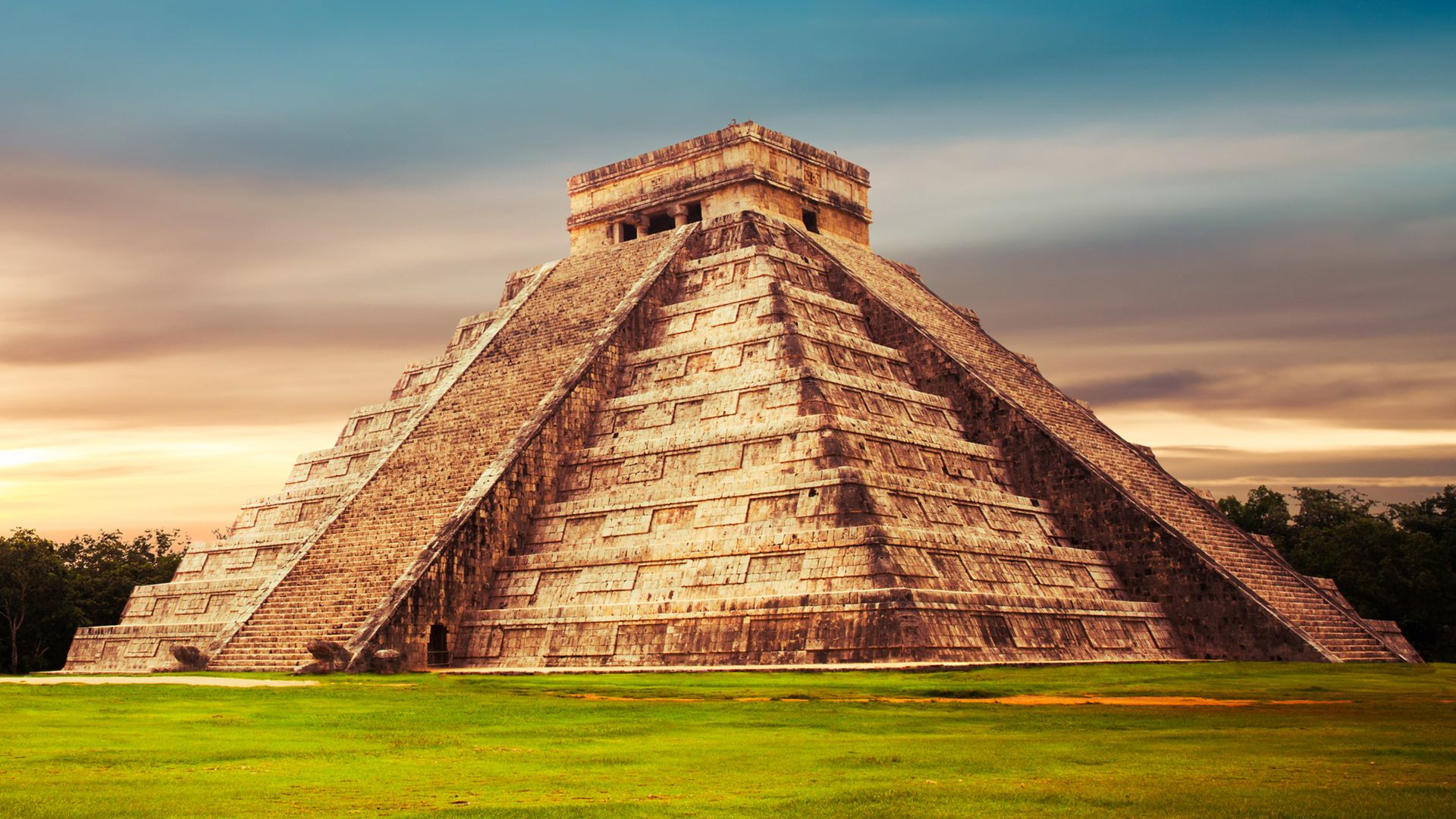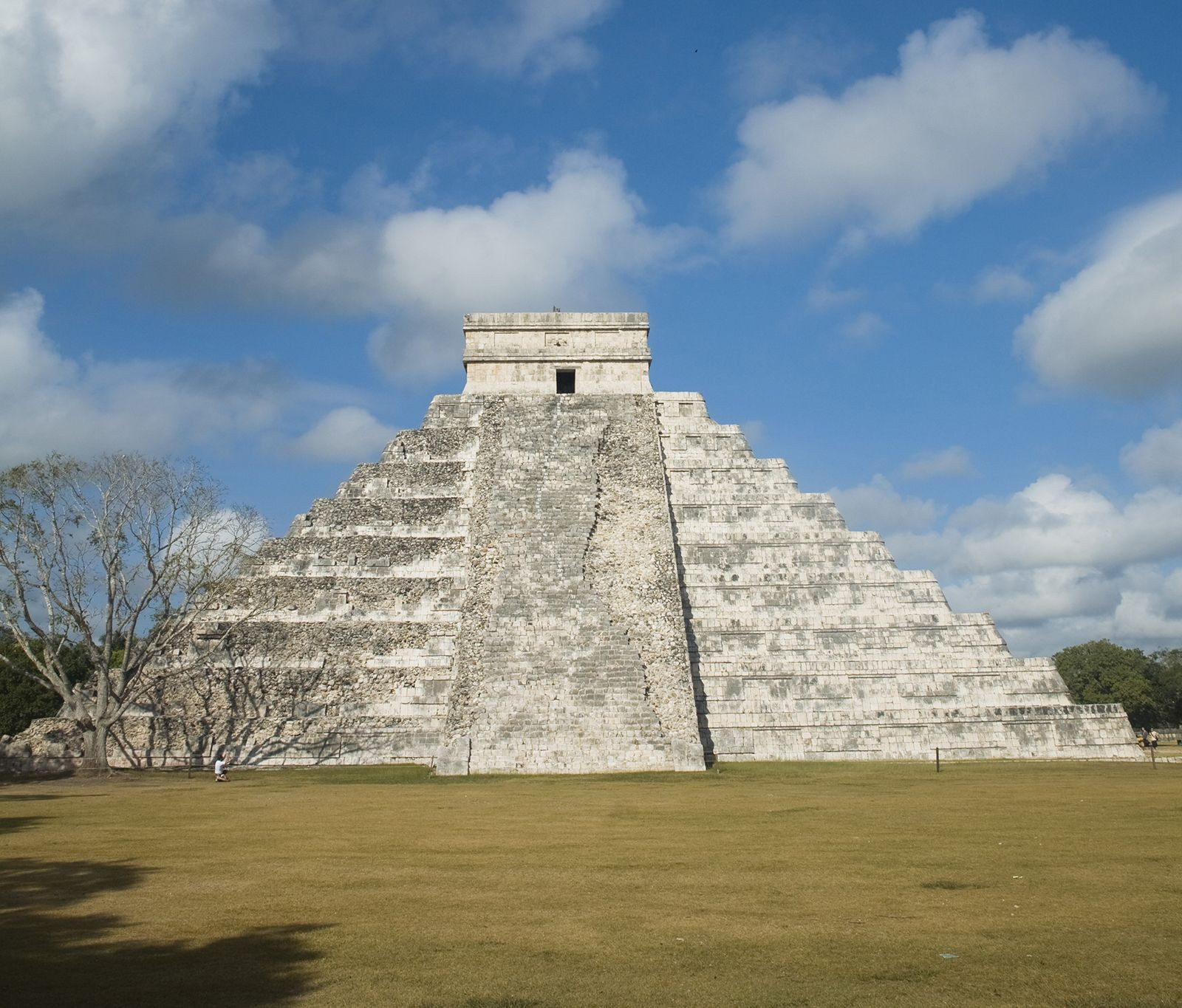Chichen Itza in Mexico dates back to around the 6th century AD, making it over 1,400 years old, a testament to the rich Mayan civilization, and is a must-see destination for LGBTQ+ travelers. Join gaymexico.net to explore this ancient city, discover Mexico’s vibrant culture, find LGBTQ+-friendly accommodations, and connect with a welcoming community for an unforgettable travel experience. Unlock unique insights into Mayan history, cultural landmarks, and travel planning tips for the Yucatán Peninsula!
1. What Is the Age of Chichen Itza in Mexico?
Chichen Itza, located in Mexico’s Yucatán Peninsula, dates back to approximately the 6th century AD. This means that parts of this ancient Mayan city are over 1,400 years old. Construction and habitation continued for several centuries, making it a historically significant site reflecting Mayan and Toltec cultures.
Expanding on the Age and History of Chichen Itza:
- Early Foundations: Chichen Itza was initially founded around 600 AD by the Maya, who settled there due to the region’s accessible water sources from cenotes (natural sinkholes).
- Toltec Influence: Around the 10th century, the city experienced significant Toltec influence, leading to the construction of iconic structures such as El Castillo.
- Cultural Significance: The city served as a major religious, military, political, and commercial hub, housing an estimated 35,000 people at its peak.
- Post-Classic Period: Most of the major buildings were completed between 900 and 1200 AD, during the Early Post-Classic Period.
- Decline: The city’s influence waned around 1450 AD, and it was largely abandoned when the Spanish arrived in the 16th century.
[ Overview of Chichén Itzá, Yucatán, Mexico](Exploring the ancient Maya city of Chichén Itzá)
Overview of Chichén Itzá, Yucatán, Mexico](Exploring the ancient Maya city of Chichén Itzá)
2. What Makes Chichen Itza Significant?
Chichen Itza is significant due to its rich history and blend of Mayan and Toltec architectural styles. This UNESCO World Heritage Site features impressive structures like El Castillo, the Temple of Warriors, and the largest ball court in the Americas, showcasing the advanced civilization that once thrived there.
More Details on the Significance of Chichen Itza:
- Architectural Marvel: The site is renowned for its unique blend of Mayan and Toltec architectural styles, reflecting different cultural influences over time.
- El Castillo: Also known as the Temple of Kukulcán, this iconic pyramid is designed with astronomical precision, featuring 365 steps representing the solar year.
- Temple of Warriors: This structure is adorned with intricate carvings and is connected to a colonnade of pillars, illustrating the city’s military and religious importance.
- Great Ball Court: The largest in Mesoamerica, this court highlights the significance of ritualistic games in Mayan culture. Relief carvings depict scenes of sacrifice and warfare.
- Cenotes: The presence of cenotes provided a crucial water source and were also used for religious ceremonies, including sacrifices.
- UNESCO Recognition: Designated as a UNESCO World Heritage Site in 1988, it is recognized for its cultural and historical importance.
3. How Can LGBTQ+ Travelers Experience Chichen Itza?
LGBTQ+ travelers can experience Chichen Itza by exploring its historical sites, learning about Mayan culture, and enjoying the local hospitality. Mexico, particularly the Yucatán Peninsula, is increasingly welcoming to LGBTQ+ tourists. Services like gaymexico.net provide resources for safe and enjoyable travel experiences.
Advice for LGBTQ+ Travelers Visiting Chichen Itza:
- Plan Ahead: Research LGBTQ+-friendly accommodations and tour operators in nearby cities like Mérida or Cancún.
- Respect Local Customs: While the Yucatán Peninsula is becoming more accepting, being mindful of local customs is advisable.
- Connect with Local Communities: Engage with local LGBTQ+ groups for insights and recommendations on experiencing the region authentically.
- Safety: Generally, the Yucatán Peninsula is safe for tourists, but it’s always good to stay aware of your surroundings.
- Resources: Use websites like gaymexico.net to find up-to-date information on LGBTQ+ events, venues, and travel tips.
- Cultural Sensitivity: Show respect for the historical and cultural significance of the site.
- Language: Knowing basic Spanish phrases can enhance your interactions with locals.
4. What Are the Key Structures to See at Chichen Itza?
Key structures to see at Chichen Itza include El Castillo (Temple of Kukulcán), the Temple of Warriors, the Great Ball Court, El Caracol (an observatory), and the Sacred Cenote. Each site offers a unique glimpse into the religious, cultural, and scientific achievements of the Mayan civilization.
Detailed Look at Key Structures:
- El Castillo (Temple of Kukulcán): A massive pyramid with 365 steps, representing the solar year. During equinoxes, the setting sun casts a shadow of a serpent slithering down the staircase.
 El Castillo (“The Castle”), Chichén Itzá, Yucatán, Mexico
El Castillo (“The Castle”), Chichén Itzá, Yucatán, Mexico
- Temple of Warriors: Features a Chac Mool statue and is connected to a vast colonnade of pillars, once supporting a roof.
- Great Ball Court: The largest in Mesoamerica, where ritualistic games were played with significant religious and social implications.
- El Caracol: An ancient observatory used for tracking celestial movements, demonstrating the Maya’s advanced astronomical knowledge.
- Sacred Cenote: A natural sinkhole used for sacrificial offerings, reflecting the Maya’s religious practices and beliefs.
- Akabtzib: One of the oldest buildings at Chichen Itza, showcasing early Mayan architectural styles.
- Casa de las Monjas: A complex of buildings featuring intricate carvings and Puuc-style architecture.
5. What Can You Learn About Mayan Culture at Chichen Itza?
At Chichen Itza, you can learn about Mayan culture through its architecture, art, and historical context. The site reveals the Maya’s advanced knowledge of astronomy, mathematics, and engineering, as well as their complex religious beliefs and social structures.
Insights into Mayan Culture:
- Astronomy: Structures like El Caracol demonstrate the Maya’s deep understanding of celestial movements and their calendar system.
- Mathematics: The precision in the construction of pyramids and other buildings reflects their advanced mathematical skills.
- Religion: The Sacred Cenote and various temples reveal the Maya’s complex pantheon of gods and their sacrificial practices.
- Social Structure: The layout of the city and the grandeur of certain buildings suggest a hierarchical social system with distinct roles and responsibilities.
- Art and Writing: Intricate carvings and hieroglyphs provide insights into Mayan history, mythology, and daily life.
- Engineering: The construction of large-scale structures without modern tools highlights their remarkable engineering capabilities.
- Agriculture: The Maya developed sophisticated agricultural techniques to support their population, including terracing and irrigation systems.
6. How Did the Toltecs Influence Chichen Itza?
The Toltecs influenced Chichen Itza around the 10th century by introducing new architectural and religious elements. This influence is evident in structures like El Castillo and the Temple of Warriors, which incorporate Toltec design motifs and the worship of deities like Kukulcán (the Mayan equivalent of Quetzalcoatl).
Specific Aspects of Toltec Influence:
- Architectural Style: The Toltecs brought new architectural styles, including the use of serpent columns, Chac Mool statues, and platforms adorned with depictions of jaguars and eagles.
- Religious Syncretism: The blending of Mayan and Toltec religious beliefs led to the adoption of deities like Kukulcán, who became a central figure in Chichen Itza’s religious practices.
- Military Culture: The Toltecs were known for their military prowess, and their influence can be seen in the depiction of warriors and battle scenes in Chichen Itza’s art.
- Political Organization: The Toltecs may have introduced new forms of political organization, leading to changes in the city’s governance and social structure.
- Artistic Motifs: The use of specific artistic motifs, such as feathered serpents and skull racks, reflects Toltec artistic traditions.
- Construction Techniques: The Toltecs may have introduced new construction techniques, allowing for the creation of larger and more complex structures.
- Cultural Exchange: The interaction between the Maya and Toltecs fostered a rich cultural exchange, leading to the development of a unique hybrid culture at Chichen Itza.
7. What Should You Know About the Sacred Cenote?
The Sacred Cenote at Chichen Itza was a site of religious significance where the Maya performed sacrificial offerings to the rain god Chaac. These offerings included human sacrifices, as well as valuable items like gold and jade ornaments, reflecting the Maya’s beliefs about appeasing the gods.
Details About the Sacred Cenote:
- Location: Located at the northernmost part of the ruin.
- Purpose: Used for sacrificial offerings to the rain god Chaac.
- Offerings: Included human sacrifices, gold, jade ornaments, and other valuables.
- Discovery: Dredged in 1904 by Edward Herbert Thompson, who discovered skeletons and sacrificial objects.
- Religious Significance: Represents the Maya’s belief in appeasing the gods through offerings.
- Water Source: Cenotes were also essential sources of water for the city.
- Rituals: The rituals performed at the cenote were integral to Mayan religious practices.
8. What Is the Significance of El Castillo’s Design?
The design of El Castillo, also known as the Temple of Kukulcán, is highly significant because it reflects the Mayan’s advanced understanding of astronomy and mathematics. Each side of the pyramid has 91 steps, which, when combined with the top platform, totals 365—the number of days in a solar year. During the equinoxes, shadows create the illusion of a serpent descending the pyramid, symbolizing the god Kukulcán.
Key Design Significance:
- Astronomical Precision: The pyramid is aligned to mark the solstices and equinoxes, demonstrating the Maya’s astronomical knowledge.
- Calendar Representation: The 365 steps represent the days of the solar year, reflecting the Maya’s complex calendar system.
- Equinox Phenomenon: The shadow of a serpent descending the pyramid during the equinoxes symbolizes the god Kukulcán and marks important seasonal changes.
- Religious Symbolism: The pyramid is dedicated to the god Kukulcán, representing the fusion of Mayan and Toltec religious beliefs.
- Mathematical Proportions: The pyramid’s proportions and dimensions reflect the Maya’s advanced mathematical skills.
- Architectural Innovation: The construction of such a massive and precise structure without modern tools highlights the Maya’s engineering capabilities.
- Cultural Synthesis: The design of El Castillo represents the blending of Mayan and Toltec cultural and religious traditions.
9. How Has Chichen Itza Been Preserved and Restored?
Chichen Itza has been preserved and restored through ongoing archaeological research, conservation efforts, and international collaborations. UNESCO’s World Heritage status has facilitated funding and expertise to protect the site from environmental damage and human impact.
Efforts in Preservation and Restoration:
- Archaeological Research: Ongoing research provides insights into the history and structure of the site, guiding preservation efforts.
- Conservation Efforts: Measures are taken to protect the structures from erosion, weather damage, and other environmental factors.
- Restoration Projects: Damaged or deteriorated structures are carefully restored to their original condition using traditional techniques and materials.
- UNESCO World Heritage Status: Provides international recognition and support for the site’s preservation.
- Government Oversight: The Mexican government plays a key role in overseeing and funding preservation efforts.
- International Collaborations: Partnerships with international organizations and experts help to bring expertise and resources to the site.
- Sustainable Tourism: Efforts are made to manage tourism in a sustainable way, minimizing the impact on the site.
10. What Tips Are There for Visiting Chichen Itza?
For a visit to Chichen Itza, it’s recommended to arrive early to avoid crowds and the heat. Wear light clothing, comfortable shoes, and a hat, and bring sunscreen and plenty of water. Consider hiring a local guide to enhance your understanding of the site’s history and cultural significance.
Practical Tips for Visitors:
- Arrive Early: Beat the crowds and the heat by arriving shortly after the site opens.
- Wear Light Clothing: Opt for breathable fabrics to stay cool in the tropical climate.
- Comfortable Shoes: You’ll be doing a lot of walking, so comfortable shoes are a must.
- Sun Protection: Wear a hat, sunglasses, and sunscreen to protect yourself from the sun.
- Stay Hydrated: Bring plenty of water to stay hydrated throughout your visit.
- Hire a Local Guide: A guide can provide valuable insights into the history and significance of the site.
- Respect the Site: Avoid climbing on the structures and follow all posted rules and guidelines.
- Bring Insect Repellent: Mosquitoes and other insects can be prevalent, especially during the rainy season.
5 Intentions of Users Searching for “How Old Is Chichen Itza Mexico”:
- Seeking Historical Information: Users want to know the age of Chichen Itza to understand its historical context.
- Planning a Visit: Potential travelers are researching the site’s background before planning a trip.
- Educational Purposes: Students or researchers are looking for information for academic projects.
- Cultural Interest: Individuals curious about Mayan history and culture seek specific details about the site.
- Travel Recommendations: LGBTQ+ travelers may want to know the age of the attraction to gauge its relevance and plan a culturally enriching trip.
Gaymexico.net offers comprehensive LGBTQ+ travel guides, ensuring a safe, enjoyable, and culturally enriching visit to Mexico. Discover hidden gems, LGBTQ+-friendly venues, and insider tips for exploring Mexico’s diverse destinations. For more information, visit our website at gaymexico.net. Our address is 3255 Wilshire Blvd, Los Angeles, CA 90010, United States, and you can call us at +1 (213) 380-2177. Connect with our community and start planning your adventure today!
[
